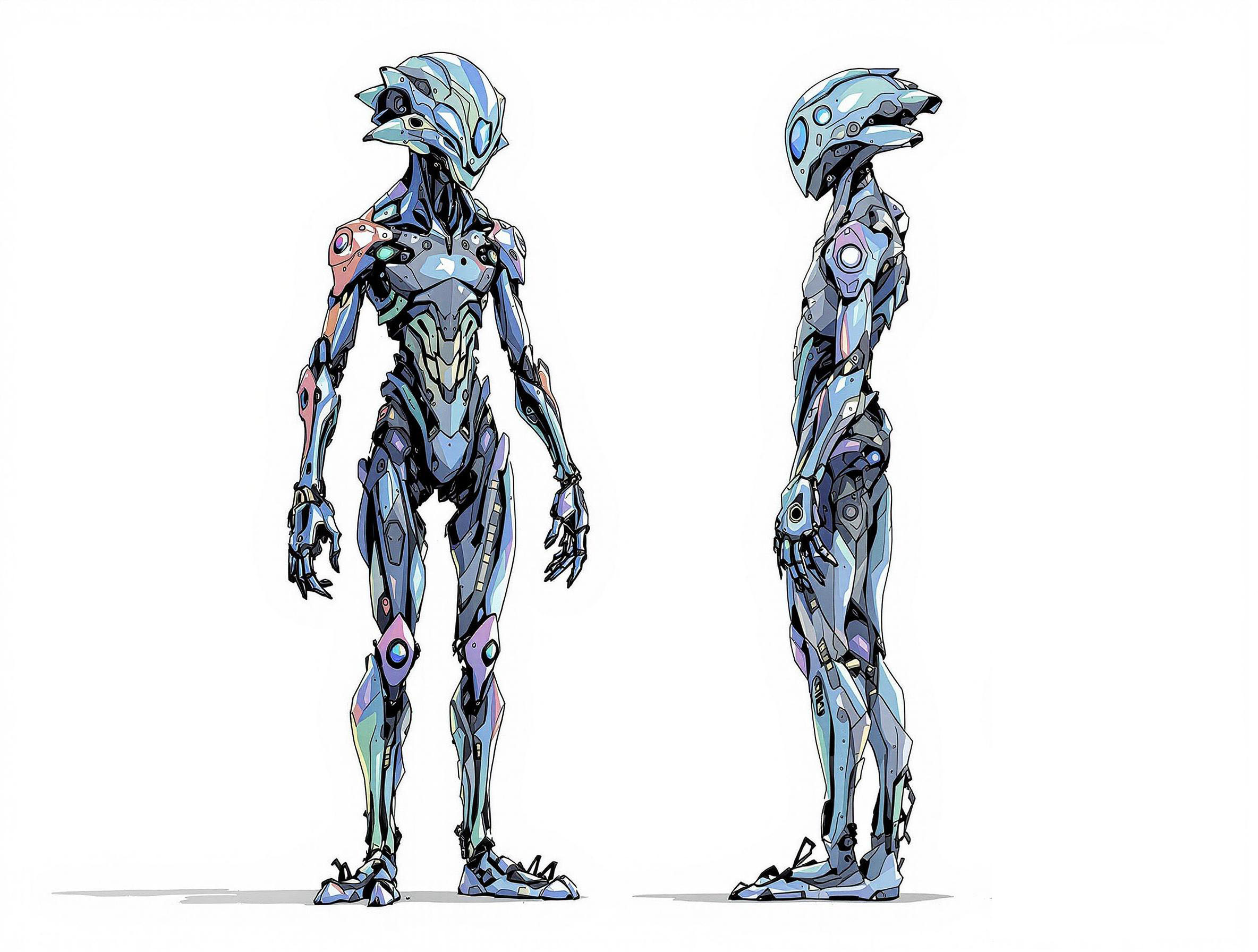The universe is a fascinating yet unforgiving place. It wasn't designed to host life as we know it. Yet, we wonder: what if a human could survive anywhere? Not just on distant planets, but in the cosmic void, inside the heart of a star, or even beyond the event horizon of a black hole? In this article, we'll explore how our bodies would need to evolve to face the universe's most extreme conditions, based on what we know from science.
Breathing the Void: A Bio-chemistry Beyond Oxygen
One of the first hurdles in space is the total absence of oxygen. Our respiratory system, adapted to Earth's rich atmosphere, would become useless in the void. Without oxygen, our lungs would collapse, and gases in our blood would expand, causing embolisms and loss of consciousness in seconds.
To survive, we'd need to completely rethink our metabolism. Some terrestrial organisms, like certain extremophile bacteria, give us clues. These bacteria survive in oxygen-free environments using anaerobic metabolism, which relies on compounds like sulfur or iron for energy. Imagine a human with an alternative bio-chemistry, based on low-energy but constant chemical reactions, capable of sustaining vital functions even in the void.
Additionally, we could integrate a network of bio-energetic nanocells into our bodies—tiny artificial organelles that store energy in high-density compounds. These systems would function like biological batteries, allowing us to "live off the grid" for years, releasing energy only when needed.
Cosmic Skin: A Living Exoskeleton Against Radiation
In space, radiation is lethal. We're exposed to gamma rays, X-rays, and high-energy particles from the Sun and deep cosmos. Even a simple spacewalk today requires a pressurized, reflective, multi-layered suit. But what if our bodies themselves became space suits?
Skin suited for space would need to be multifunctional: protecting against mechanical damage, like micro-meteorite impacts, and effectively shielding against ionizing radiation. Materials like carbon nanotubes, graphene, and aerogel are already promising. Imagine these materials integrated into living tissue: skin capable of self-repair, changing shape and density based on the environment, altering albedo to reflect more or less light, and even generating an epidermal magnetic field to deflect charged particles.
This skin could have a structure similar to the scales of deep-sea fish or pangolin scales but reinforced with nearly indestructible materials. A true living exoskeleton, sensitive to touch but impenetrable, capable of surviving the harshest solar rays and deepest shadows.
Unyielding Blood: Vital Fluid in Extreme Conditions
In the void, bodily fluids behave unpredictably. Human blood can boil at room temperature if the external pressure is low enough. This phenomenon, called explosive boiling, would destroy our circulatory system in moments.
To prevent this, the vital fluid of the ultimate human would need to be denser, more stable, and less volatile. Imagine a liquid similar to supercritical plasma, capable of remaining fluid even without pressure, and enriched with self-repairing nanoparticles. Add to this a pressure-controlled circulatory system with multiple hearts arranged in series along the body, able to locally modulate blood flow based on gravity, temperature, and spatial orientation.
This network could also integrate autonomous thermoregulation, inspired by the capillary networks of camels or desert reptiles but enhanced to balance environments from -270°C to millions of degrees.
Timeless Brain: Consciousness in Spacetime
Space is not only hostile to the body but also to the mind. Sensory deprivation, the lack of day-night signals, time dilation, and constant radiation exposure disrupt cognitive functions, causing psychosis, hallucinations, and depression.
A being designed to traverse infinite space would need an extremely plastic brain, capable of adapting to the most extreme environmental and temporal changes. This brain could be protected by an active neural shield, a magnetic field generated by specialized structures in the skull, capable of screening out radiation and stabilizing electrochemical signals.
Moreover, for millennia-long journeys, the brain would need to hibernate, not just physically but mentally. A "deep dream mode" where consciousness is suspended, and brain activity is reduced to a minimum, leaving only emergency circuits active. Just like certain hibernating animals on Earth, but on a cosmic scale.
Surviving Inside a Star: Enduring Millions of Degrees
Stars are nuclear furnaces. The Sun, for example, has a surface temperature of 5,500°C and a core exceeding 15 million degrees. No terrestrial life form could approach without being vaporized.
But there's a type of matter that withstands such conditions: degenerate matter, found inside white dwarfs. This matter consists of atoms compressed to nearly eliminate the space between particles, forming an extremely stable quantum fluid. If a human body could be constructed from degenerate tissues, bound by strong nuclear forces and maintained by internal gravitational confinement fields, it could literally swim in stellar plasma.
This body wouldn't burn; it would temporarily merge with the star, then emerge unscathed.
Crossing the Event Horizon: Surviving a Black Hole
The ultimate challenge: the black hole. Objects with gravity so intense they warp spacetime, closing in on themselves. Nothing escapes, not even light. But what would truly happen to a perfect being falling into one?
According to general relativity, it would be spaghettified—stretched to infinity. But a body composed of organic metamaterial, with still-hypothetical properties, could interact differently with spacetime. This matter could change density, shape, and size in response to curvature, avoiding destruction.
And consciousness? If distributed in a quantum network, it could fragment into different entities, each continuing to exist in parallel realities, inside or outside the event horizon. This being wouldn't survive in the human sense... but it wouldn't die either. It would exist.
The Cosmic Human: Anatomy of an Impossible Being
It's no longer just a human. Nor a cyborg. It's a hybrid of biology, quantum engineering, and exotic matter. After billions of years, evolution has given way to design. This is the ultimate human: an organism forged to survive in every corner of the universe.

Cosmic Human Artwork
Exterior: Stellar Skin and Alien Symmetry
At first glance, the impact is striking. Standing between 2 and 3 meters tall, with a perfectly upright posture even in zero gravity, this being is covered in liquid-scaled dermo-epidermis, resembling a shimmering mosaic. The scales change color to camouflage, reflect radiation, or disperse heat, and move imperceptibly, like a living magnetic field.
Instead of hair, photonic sensory fibers detect environmental changes, communicating through pulsating lights and electromagnetic modulations. The eyes—if we can still call them that—are multiple spheroids, capable of independent rotation, covering the entire electromagnetic spectrum: from infrared to gamma rays. The mouth no longer serves for breathing or eating but has become an organ of vibrational emission, used to communicate through sounds, waves, and even quantum fields.
The hands have more than five fingers, each independently articulated and equipped with electrically sensitive tactile hairs to interface with any matter or technology. The feet are multiform, adaptable to any terrain: they can become suction cups, claws, or molecular-level anchors.
Interior: Quantum Biomechanics and Distributed Consciousness
Beneath the skin, the structure is even more alien. The skeleton is made of self-regenerating nanotissues, capable of absorbing energy from impacts, deflecting micro-meteorites, and adapting to any gravitational force. The muscles are not organic but consist of shape-memory fiber bundles that can stiffen or liquefy as needed.
There isn't a single heart but a network of six hearts distributed along the body, each connected to a specific part of the circulation. The blood is a colloidal fluid rich in superions, designed to function as a nutrient, thermal conductor, and informational liquid in case of neurological damage.
Digestive organs no longer exist in the traditional sense. The being feeds on radiation, interstellar dust, and subatomic particles. A series of atomic transformation chambers in the torso allow any material to be converted into useful energy.
And finally, the brain: no longer confined to the skull. It's a distributed network along the spine, hands, and chest, with quantum computing nodes scattered throughout the body. This makes consciousness multi-local, able to exist in multiple places simultaneously, even if parts of the body are damaged or destroyed. Memory self-regenerates, utilizing the universe's entropic patterns to reform lost data.
Extra-Human Functions
- Personal Gravitational Field: Generates microgravity to prevent molecular disintegration.
- Temporal Membrane: A tissue layer that locally slows time, allowing immediate reactions even to sub-light events.
- Atomic Reconstruction System: Each cell has a "quantum backup cloud" that can reconstruct it from scratch.
- Fluctuating Consciousness: The mind can be transported on quantum waves, transcending spatial limits.
Towards a New Form of Life
Natural evolution has brought us this far. But to face the universe in its entirety, we need a radical leap: a form of life designed for the absurd. A being capable of integrating biology with quantum physics, nanotechnology, and spacetime manipulation.
A god created by intelligence.








Leave a Comment